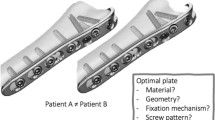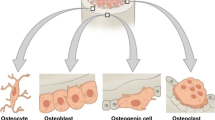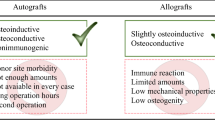Abstract
The objective of this study is to evaluate local response to a bioactive glass based composite putty (NovaBone Putty) in a vertebral body defect model in sheep, as compared to NovaBone, a bioactive glass particulate. Two time periods were used for the study, 6 and 12 weeks. Empty defects were also used as a control. In comparing the three test groups, the relative amount of new bone for both grafted defects was substantially greater than for the empty controls (P < 0.05). At 6 weeks, the bone formation was 42% for NovaBone Putty, 27% for NovaBone and 1.2% for the ungrafted empty defect. At 12 weeks, the bone formation was 51.4% for NovaBone Putty, 47.3% for NovaBone and 5.1% for the empty defect. NovaBone Putty, the test material, had greater bone content than the NovaBone, both of which were significantly greater than the empty control.


Similar content being viewed by others
References
LeGeros RZ. Calcium phosphate materials in restorative dentistry: a review. Adv Dent Res. 1988;2:164–83.
Hench LL, Splinter RJ, Greelee TK, Allen WC. Bonding mechanisms at the interface of ceramic prosthetic materials. J Biomed Mater Res. 1971;2:117–41.
Hench LL, Paschall HA. Direct bonding of bioactive glass-ceramic materials to bone and muscle. J Biomed Mater Res Symp. 1973;4:25–42.
Hench LL, West JK. Biological applications of bioactive glasses. Life Chem Rep. 1996;13:187–241.
Filgueiras MR, LaTorre GP, Hench LL. Solution effects on the surface reactions of a bioactive glass. J Biomed Mater Res. 1993;27:445–53.
Zhong JP, Greenspan DC. Bioglass surface reactivity: from in vitro to in vivo. Bioceramics. 1998;11:415–8.
Xynos ID, Edgar AJ, Buttery LDK, Hench LL, Polak JM. Gene-expression profiling of human osteoblasts following treatment with the ionic products of bioglass® 45S5 dissolution. J Biomed Mater Res. 2001;55:151–7.
Xynos ID, Hukkanen MVJ, Batten JJ, Buttery LD, Hench LL, Polak JM. Bioglass® 45S5 stimulates osteoblast turnover and enhance bone formation in vitro: implications and applications for bone tissue engineering. Calcif Tissue Int. 2000;67:321–9.
Matsuda T, Davies JE. The in vitro response of osteoblasts to bioactive glass. Biomaterials. 1987;8:275–84.
Vrouwenvelder WCA, Groot CG, de Groot K. Behavior of fetal rat osteoblasts cultured in vitro on bioactive glass and nonreactive glasses. Biomaterials. 1992;13:382–92.
Vrouwenvelder WCA, Groot CG, de Groot K. Histological and biochemical evaluation of osteoblasts cultured on bioactive glass, hydroxylapatite, titanium alloy, and stainless steel. J Biomed Mater Res. 1993;27:465–75.
Price N, Bendall SP, Frondoza C, Jinnah RH, Hungerford DS. Human osteoblast-like cells (MG63) proliferate on a bioactive glass surface. J Biomed Mater Res. 1997;37:394–400.
Loty C, Sautier JM, Tan MT, Oboeuf M, Jallot E, Boulekbache H, Greenspan D, Forest N. Bioactive glass stimulates in vitro osteoblast differentiation and creates a favorable template for bone tissue formation. J Bone Miner Res. 2001;16:231–9.
Xynos ID, Edgar AJ, Buttery LDK, Hench LL, Polak JM. Ionic products of bioactive glass dissolution increase proliferation of human osteoblasts and induce insulin-like growth factor II mRNA expression and protein synthesis. Biochem Biophys Res Commun. 2000;276:461–5.
Sun JY, Yang YS, Zhong JP, Greenspan DC. The effect of the ionic products of bioglass® dissolution on human osteoblasts growth cycle in vitro. J Tissue Eng Regen Med. 2007;1:281–6.
Oonishi H, Kushitani S, Yasukawa E, Iwaki H, Hench LL, Wilson J, Tsuji E, Sugihara T. Particulate bioglass compared with hydroxyapatite as a bone graft substitute. Clin Orthop Relat Res. 1997;334:316–25.
Chou L, Al-Bazie S, Cottrell D, Giordano R, Nathason D. Atomic and molecular mechanisms underlying the osteogenic effects of bioglass materials. Bioceramics. 1998;11:265–8.
Wheeler DL, Eschbach EJ, Hoellrich RG, Montfort MJ, Chamberland DL. Assessment of resorbable bioactive material for grafting of critical-size cancellous defects. J Orthop Res. 2000;18:140–8.
Moreira-Gonzalez A, Lobocki C, Barakat K, Andrus L, Bradford M, Gilsdorf M, Jackson IT. Evaluation of 45S5 bioactive glass combined as a bone substitute in the reconstruction of critical size calvarial defects in rabbits. J Craniofac Surg. 2005;16:63–70.
Amato MM, Blaydon SM, Scribbick FW Jr, Belden CJ, Shore JW, Neuhaus RW, Kelley PS, Holck DE. Use of bioglass for orbital volume augmentation in enophthalmos: a rabbit model (oryctolagus cuniculus). Ophthal Plast Reconstr Surg. 2003;19:455–65.
Kobayashi H, Turner AS, Seim HB 3rd, Kawamoto T, Bauer TW. Evaluation of a silica-containing bone graft substitute in a vertebral defect model. J Biomed Mater Res A. 2010;92(2):596–603.
Acknowledgments
This study was supported by research funds from NovaBone Products, LLC and from the Musculoskeletal Transplant Foundation, and the funds of the Chinese Academy of Sciences for Key Topics in Innovation Engineering (Grant No.: KGCX2-YW-207).
Author information
Authors and Affiliations
Corresponding authors
Rights and permissions
About this article
Cite this article
Wang, Z., Lu, B., Chen, L. et al. Evaluation of an osteostimulative putty in the sheep spine. J Mater Sci: Mater Med 22, 185–191 (2011). https://doi.org/10.1007/s10856-010-4175-5
Received:
Accepted:
Published:
Issue Date:
DOI: https://doi.org/10.1007/s10856-010-4175-5




